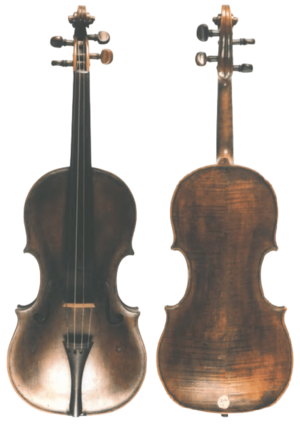George Ward (luthier) facts for kids
Quick facts for kids
George Ward
|
|
|---|---|
| Seoirse Mac an Bháird | |

Violin by Ward, c. 1750
|
|
| Born | c. 1715 Dublin, Ireland
|
| Died | c. 1769 Dublin, Ireland
|
| Nationality | Irish |
| Known for | Luthier |
|
Notable work
|
violin, NMI collection |
| Style |
|
| Movement | Irish school |
| Parent(s) |
|
| Relatives |
|
George Ward (also known as Seoirse Mac an Bháird in Irish) was a talented Irish luthier. A luthier is someone who makes or repairs string instruments like violins and cellos. George Ward lived in Dublin, Ireland, from around 1715 to 1769.
His instruments have a unique style. They also look a bit like the famous Stradivarius violins. One of his violins is kept safe at the National Museum of Ireland in Dublin. It is part of a special collection there.
Contents
Early Life of George Ward
We do not know much about George Ward's early life. Records suggest he was born in Dublin around 1715. His parents were Samuel and Mary Ward. He was likely baptized at the Church of St Nicholas Without, Dublin.
George had a brother named John (1703–1778). John was also a violin maker in Dublin. John's daughter, Isabelle, married William Gibson, who made guitars in Dublin. George Ward probably grew up and started working in Christchurch Yard in Dublin.
Ward's Career as a Luthier
Historians are not sure exactly when George Ward started making instruments. Some think he began as early as 1710. This idea comes from a label on one of his instruments, which might say 1719. However, this label might have been misread.
Other experts believe he started his career around 1750. More of his instruments from this time still exist today. But it is thought that Ward was already working as a violin maker by 1740. He worked at Christchurch Yard.
It is not known who taught Ward how to make instruments. He might have learned from Thomas Molineux. Molineux was another luthier in Dublin who also lived in Christchurch Yard. Ward used to brand his instruments with 'WARD/DUBLIN' on the back. He might have learned this from Molineux.
Between 1740 and 1750, Ward moved his workshop. He moved to Lee's Lane, near Aston Quay. It is thought that Ward might have taught a young Thomas Perry. Perry later became a famous luthier too. Their instruments look very similar. Perry also started his career at Christchurch Yard. He branded his instruments 'PERRY/DUBLIN'. He likely learned this from Ward.
In 1764, Ward moved again to Anglesea Street. He worked there until he died in 1769. Some people believe that Thomas Perry took over Ward's workshop. Perry moved to Anglesea Street around the time Ward died. This makes it more likely that Perry was Ward's student.
Ward's Unique Instrument Style
George Ward developed his own special way of making violins. We are not sure if he learned these unique traits from his teacher. Or perhaps he developed them over time. The link between Ward's style and Perry's early instruments suggests Ward had a very distinct style. Perry likely copied it as his student.
Ward's instruments also look a lot like the famous Stradivarius models. It is not known if Ward ever saw a real Stradivarius violin up close. He might have learned these features from his own teacher. Experts describe Ward as a very skilled "artist" and "maker of undoubted ability."
His surviving instruments are known for their "very handsome wood and beautiful varnish." They are also considered "quite superior" to those made by Perry. Besides branding his instruments with his name and location, Ward also added a crowned harp symbol. He placed this symbol on the button of the instrument.
|
|||||||||||||||||||||||||||||||||||||||||||||||||||||||||||||||||||||||||||||||||||||||||||||||||||||||||||||||||||||||||||||||||||||||||||||||||||||||||||||||||||||||||||||||||||||||||||||||||||||||||||||||||||||||||||||||||||||||||||||||||||||||||||||||||||||||||||||||||||||||||||||||||||||||||||||||||||||||||||||||||||||||||||||||||||||||||||||||||||||||||||||||||||||||||||||||||||||||||||||||||||||||||||||||||||||||||||||||||||||||||||||||||||||||||||||||||||||||||||||||||||||||||||||||||||||||||||||||||||
|
|||||||||||||||||||||||||||||||||||||||||||||||||||||||||||||||||||||||||||||||||||||||||||||||||||||||||||||||||||||||||||||||||||||||||||||||||||||||||||||||||||||||||||||||||||||||||||||||||||||||||||||||||||||||||||||||||||||||||||||||||||||||||||||||||||||||||||||||||||||||||||||||||||||||||||||||||||||||||||||||||||||||||||||||||||||||||||||||||||||||||||||||||||||||||||||||||||||||||||||||||||||||||||||||||||||||||||||||||||||||||||||||||||||||||||||||||||||||||||||||||||||||||||||||||||||||||||||||||||
Surviving Instruments Today
We do not know how many instruments George Ward made in his lifetime. Some of them still exist today. They sometimes appear for sale or at auctions. Others are kept in special collections and exhibits.
One of Ward's best violins was bought by the National Museum of Ireland in 1891. It is part of a collection of musical instruments. This collection features instruments made by Irish craftsmen. It includes works by Perry, Molineux, Delany, and Mackintosh.
Here are some of Ward's instruments that still exist:
Ward's Violins
- 1719: This violin has a label that says 'Made by George Ward in Anglesey Street 17 Dublin 19'. The date might have been misread.
- 1740: This violin is in the National Museum of Ireland collection. Its label says 'Made by George Ward in Lee's Lane on Aston's Quay, Dublin, 1740'.
- c. 1750: This violin is in a private collection. It is branded 'WARD/DUBLIN'.
- 1753: This violin used to be part of the Graham collection.
- 1758: This violin's label says 'Made by George Ward in Lee's Lane on Aston's Quay, Dublin, 1758'.
- 1764: This violin is labeled 'Made by George Ward in Anglesea Street in 1764'.
- 1766: This violin has a label that says 'Made by George Ward in Anglesea Street 17 Dublin 66'.
Ward's Cellos
- (?): There is a cello that is similar to the 1753 violin.
See also
- Thomas Molineux (Irish luthier)
- Thomas Perry (Irish luthier)

